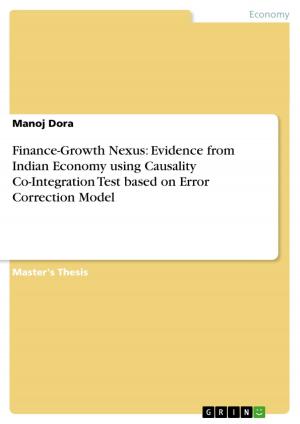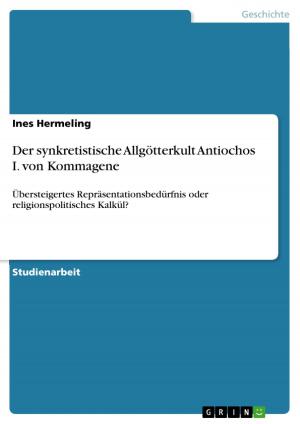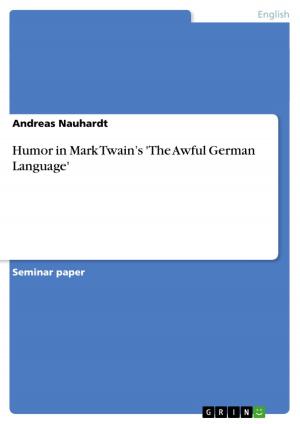The Historical Emergence of the Main Forms of Actors in the Middle East and North Africa region
Nonfiction, Social & Cultural Studies, Political Science, Politics, History & Theory| Author: | Nassef Adiong | ISBN: | 9783640243860 |
| Publisher: | GRIN Publishing | Publication: | January 15, 2009 |
| Imprint: | GRIN Publishing | Language: | English |
| Author: | Nassef Adiong |
| ISBN: | 9783640243860 |
| Publisher: | GRIN Publishing |
| Publication: | January 15, 2009 |
| Imprint: | GRIN Publishing |
| Language: | English |
Essay from the year 2008 in the subject Politics - Political Systems - History, grade: A, Technological University of the Philippines (Political Science), course: for college papers, 17 entries in the bibliography, language: English, abstract: This paper will focused on the historical antecedents of actors involved in creating and developing Middle East and North Africa (MENA) region, and what are the differences amongst them. The timeline will begin in the aftermath of the Ottoman Empire that materialized into the advent of the European colonizations and birth of nation-states. Revolutions spark all over the Fertile Crescent, when the Arabs knew that the twilight of the Ottomans are now commencing. According to Aroian and Mitchell (1984, p. 164), from the 1919 Syrian resistance that was affirmed by their French protectors through the provisions laid down in the League of Nations has led to the Iraqi revolt of 1920, which was resembled by British India and Egypt in the days of Lord Cromer because they were inspired by the Syrian revolution. The premise is that all of the Arabian Peninsula is interconnected to each other with regards to their struggle for freedom and independence. Halpern (1963, p. 256) contends that the San Remo Conference, in addition to confirming allied plans for Iraq and Syria, granted Britain a mandate that combined Palestine and Transjordan (the area across or east of the Jordan River). Prior to the partition, Palestine had been part of greater Syria, while present-day Jordan was viewed as part of both Syria and Arabia. Ottoman administrative divisions had not included the terms Palestine and Jordan. When Britain obtained the mandate for Palestine at San Remo, the intention was that a national home for Jews should be set up in Palestine, but it was stated explicitly that not all conditions of the mandate would necessarily apply to the entire area.
Nassef is a lifelong learner of comparative study between Islam and International Relations. He created the IR-IS Research Cohort on December 2012 that became Co-IRIS (International Relations and Islamic Studies Research Cohort) on November 2013. In addition to his service to profession, he founded the Philippine International Studies Organization (PHISO) on September 2015.
Essay from the year 2008 in the subject Politics - Political Systems - History, grade: A, Technological University of the Philippines (Political Science), course: for college papers, 17 entries in the bibliography, language: English, abstract: This paper will focused on the historical antecedents of actors involved in creating and developing Middle East and North Africa (MENA) region, and what are the differences amongst them. The timeline will begin in the aftermath of the Ottoman Empire that materialized into the advent of the European colonizations and birth of nation-states. Revolutions spark all over the Fertile Crescent, when the Arabs knew that the twilight of the Ottomans are now commencing. According to Aroian and Mitchell (1984, p. 164), from the 1919 Syrian resistance that was affirmed by their French protectors through the provisions laid down in the League of Nations has led to the Iraqi revolt of 1920, which was resembled by British India and Egypt in the days of Lord Cromer because they were inspired by the Syrian revolution. The premise is that all of the Arabian Peninsula is interconnected to each other with regards to their struggle for freedom and independence. Halpern (1963, p. 256) contends that the San Remo Conference, in addition to confirming allied plans for Iraq and Syria, granted Britain a mandate that combined Palestine and Transjordan (the area across or east of the Jordan River). Prior to the partition, Palestine had been part of greater Syria, while present-day Jordan was viewed as part of both Syria and Arabia. Ottoman administrative divisions had not included the terms Palestine and Jordan. When Britain obtained the mandate for Palestine at San Remo, the intention was that a national home for Jews should be set up in Palestine, but it was stated explicitly that not all conditions of the mandate would necessarily apply to the entire area.
Nassef is a lifelong learner of comparative study between Islam and International Relations. He created the IR-IS Research Cohort on December 2012 that became Co-IRIS (International Relations and Islamic Studies Research Cohort) on November 2013. In addition to his service to profession, he founded the Philippine International Studies Organization (PHISO) on September 2015.















